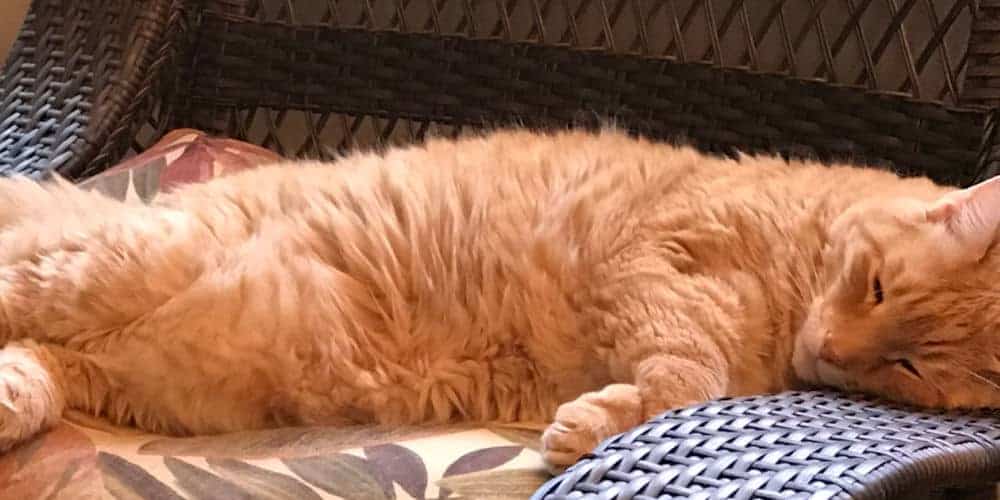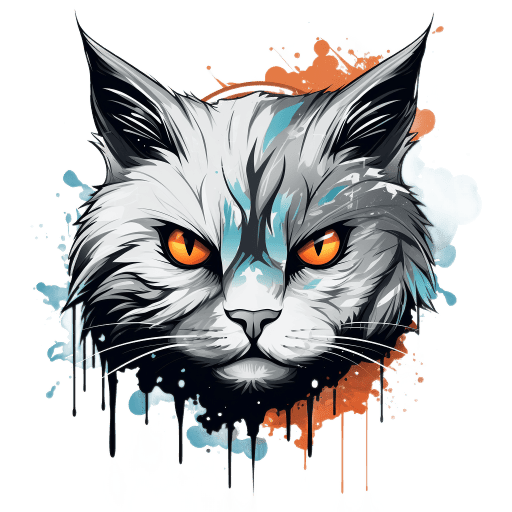Ginger Cat Breeds: The Purrfect Guide

On-screen and off, ginger cats captured our hearts and eyes with their distinctive orange coats for as long as we can remember. They even have their own appreciation day! After all, who doesn’t know lasagna’s number one fan, Garfield, or Cat from Breakfast at Tiffany’s?
Let’s take a deeper dive into what makes these fiery-coated felines special, and how ginger cat breeds have become one of the most loveable types out there.
Cat Attitudes is reader-supported. When you buy through links on our site, we may earn an affiliate commission.
How Many Ginger Cat Breeds Are There?
While ginger doesn’t qualify as a breed, there’s a variety of cats, pedigree or not, that sport coats with different shades of red and orange. Although most of these breeds aren’t originally orange in hue, they have a higher chance of being ginger:
British Shorthair
This muscular-looking breed with its dense coat is a family favorite. They’re well known for their blueish-gray color, but they can be found in a light orange shade. British shorthairs require daily brushing to avoid matting. They also need regular exercise and a balanced diet to keep in good shape and form.
Persian
Known for their silky, long coats, sunken muzzles, and enormous eyes, this cat breed is one of the most popular worldwide. Although they’re laid back, they still need to be exercised and well-fed.
Persian cats are high maintenance when it comes to grooming because of their long fur. But they’re calm and cuddly companions.
Maine Coon
While this large breed comes in a large array of colors, the orange Maine Coon can be seen in 5 coat variations. Maine coons are gentle giants. Their sweet tempers and soft meows are balanced by their loud thumping across floors. They require frequent grooming due to their long coats.
Munchkin
These forever kittens are perhaps the cutest breed out there. Due to their genetic mutation, they have very short legs, and seeing them in their ginger coats only makes them cuter. However, their adorable appearance comes with a higher risk of osteoarthritis.
Abyssinian
You can’t miss this breed with its long, slender body and its large, alien-like ears. Ginger Abyssinians sport a soft orange, almost coppery color with a ticked pattern. The Somali cat breed also has a similar coat. Their short coats require less frequent grooming.
Abyssinians are prone to kidney disease and infections and abscesses.
American Bobtail
This crop-tailed breed can be seen in spotted and striped variations. The orange coat is usually a blend of light orange and a darker stripe. Similar to Garfield’s coat. They’re highly intelligent and create strong bonds with their humans.
Bobtails are extremely playful and enjoy hunting. Although they’re a quiet breed, you can catch them trilling or chirping when excited. Their active nature puts them at risk of hip dysplasia, which opens up the potential for lameness, crippling, and arthritis of the hip joints.
While bobtails were named after their bobbed tails, they don’t necessarily have stumpy tails. Those who do can be at risk of spinal problems.
Bengal
This rare breed’s distinctive coat patterns are a mix of cheetah spots and tiger stripes. Orange Bengals have a striking coppery orange coat with dark orange-brown markings.
Despite their wild ancestry, Bengal house cats are affectionate and gentle. Their athletic nature will show in their need to jump, run, and exercise frequently. They’re also low maintenance when it comes to grooming, thanks to their short coats.
Scottish Fold
While this breed is now banned, due to its dominant gene mutation that causes the folded ears, you can still see them sporting a solid light orange coat, or light and dark stripes.
Aside from their famous ears, this breed is known to suffer from a stiff tail that can cause them pain when mishandled. Scottish folds also shed a lot. Other than that, they’re ideal family cats.
Egyptian Mau
With as little as 3,000 Maus around the world, an orange Mau is even rarer. Ginger Maus have a bronze-like base with dark brown or black markings.
Maus are famous for their triangular heads and large, green, almond eyes. They demand a lot of attention from their owners and tend to enjoy having the upper ground to survey their surroundings. This means you’ll need to equip your home with cat perches and trees or else you might find your cat on top of the fridge.
Egyptian Maus are susceptible to feline asthma, cystitis, heart disease, and mouth and gum disease.
Each breed rocks the ginger look in its own way, making each cat one of a kind. From pastel orange to flaming red fur, ginger cat breeds are as fascinating as they are rare.
What About Tabby Cats?
The word tabby doesn’t refer to a breed, hence why we left it out in the list above, it actually refers to unique patterns that show on a cat’s coat. Tabby patterns are split into four types:
Spotted Tabby
Markings show as small or large spots and can sometimes show as swirls. The spots can be randomly placed or in straight lines.
Classic Tabby
Similar to tie-dye, the markings resemble marble or large blotches and swirls. The markings are usually in curved bands around the cat’s entire body.
Mackerel Tabby
This coat pattern has narrow, long stripes, similar to a tiger’s. But the name comes from the stripes looking like a fish’s skeleton.
Agouti or Ticked Tabby
Perhaps the least noticeable pattern, these markings are small speckles that look like sand.
Another quirky feature of tabbies is black freckles on their face. Noticeably on their nose, lips, and sometimes their gums. The freckles start to appear when the cat’s between 1-2 years old.
Almost all cat breeds have a tabby variation to their coats, some can even have all variations, like Maine Coons. While not all tabbies are orange in color, most cats that are orange can be categorized as tabby. This explains why some people nickname ginger cats as tabby.
What Makes a Cat Ginger?
Similar to their human counterparts, ginger cats are a result of the ‘red gene’, or the pheomelanin pigment. There are two main genetic variants: O and o. The O variant is responsible for the red pigment when carried down the genetic line, and the o variant doesn’t carry the fiery pigment.
The O variant is carried down through the X chromosome. Since male cats have one, their chances of having the dominant gene being the O variant are higher. While females will need two O variants (OO) to be fully ginger. If either gender ends up with the o variant instead, their coats will likely be tortoiseshell or calico instead.
Too sciencey? Let’s put it this way: to get a red male cat, his mom has to have a red, tortoiseshell, or calico coat. To get a red female cat, she’ll have to be a cross between a red-coated dad, and a red, tortoiseshell, or calico-coated mom.
As you may have guessed already, due to the genetic nature of being red, the majority of ginger cats are male.
Personality and Behavioral Traits
Do ginger cats have a feisty personality to match their fiery coats? According to most ginger cat owners, they’re quite easygoing!
While we can’t guarantee that all orange cats hate Mondays and love lasagne, we do know that their laid-back demeanor and loving nature are unmissable. We can, however, guarantee that they’ll give you the Puss in Boots wide-eyed look when hungry.
Some of the most prominent traits observed by orange cat owners are:
Brave. You won’t see them sulking around in the face of danger. And by danger we mean vacuums.
Independent. Sure they love to cuddle and hang around with you, but they can also prefer some me time and not being bossed around.
Loving. Ginger cats are cuddle bugs and will always sneak a snuggle whenever they can.
Tolerant. This makes them ideal family pets since they don’t mind children or other pets.
Although behavioral traits aren’t necessarily due to coat color, ginger cats seem to be bolder, and more independent than others. Some can even seem aloof and uninterested in their two-legged friends, while others may be chatty.
Remember Garfield? Although his love for food was comical, it translates into real-life orange cats too. Ginger cats are known foodies and tend to gain weight more easily than other cats. Make sure to monitor their diets and don’t feed them lasagne.
Frequently Asked Questions
Time to answer some of the most common questions about ginger cats.
Do Ginger Cats Live Longer?
A cat’s lifespan is not related to its coat’s color. Most cats live till the age of 12-15 years old. Healthier cats can even live longer. The same applies to ginger cats.
Do Ginger Cats Have a Unique Eye Color?
Ginger cats don’t have a specific eye color to go with their coats and can be any of the following: green, yellow, copper, and topaz.
Are Ginger Cats More Prone To Diseases?
While their special genetics make their appearance one of a kind, it doesn’t introduce any particular diseases or syndromes. Medical issues can be traced back to the cat’s breed for a heads up on what your cat might face. As always, regular checkups at the vet will help detect any illness early on and prevent it.
How Many Shades of Ginger Are There?
While we end up calling them ginger or orange cats, there are multiple shades, such as:
- Mellow yellow or butter
- Yellowish orange or ginger
- Butterscotch
- Orange
- Caramel orange
- Red
Are All Ginger Cats Male?
No, but due to their genetics, they’re more likely to be orange-coated than females. However, this doesn’t mean that there aren’t ginger female cats.
How Much Do Ginger Cats Cost?
Since the color is somewhat rare, ginger cats tend to be slightly pricier than other coat colors. Orange cats seem to have some of the highest adoption rates. This could be because of their constant appearances on-screen that showcased their loving personalities.
Final Thoughts
From the silver screen to the living room couch, ginger cats are here to stay. Their gorgeous color and friendly temperament are what made them so popular among us humans.
While their uniqueness can warrant a breed on its own, sadly, ginger isn’t a breed. However, that doesn’t deny the fact that there are ginger cat breeds out there that share each breed’s unique characteristics with the fierce coat coloring.
